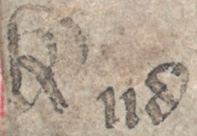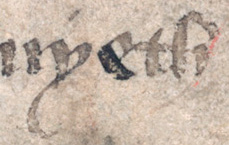|
| A |
 | Usage: ancres
double compartment 'a' used throughout with little variation. |  | Usage: As
just one of a variety of upper case 'A's used by this scribe. The first letter of the line is set apart slightly. |
 | Usage: A
a second form of upper case 'A' which may vary on each occasion with added tags to limbs, serrated ends to the lobe and variation in angularity. |  | Usage: And
an unusual upper case 'A' which is used by Scribe D occasionally. It is also found in the hands of clerks copying entries into the Letter Books copied at the London Guildhall. |
|
| D |
 | Usage: dyches
'd' in initial position. The lobe is squarish with upper loop curving backwards to a point where an oblique downstroke angles back to close the graph. |  | Usage: And
there are no tags or flourishes on 'd' in final position. In this example, the loop is not so sharply angled. |
 | Usage: Bidders
the oblique down-stroke runs parallel to the left side of the lobe. |  | Usage: dredful |
|
| G |
 | Usage: glee
double compartment anglicana 'g' used throughout. |  | Usage: clothyng
the head of the upper compartment comprises thick strokes to right and left and hairline strokes to top and bottom. The forward slash leaves the upper compartment from the middle point where the thick right-hand stroke ends. |
 | Usage: wandryng
a final 'g' with squashed and pointed lower compartment. The hand of Scribe D shows 'g' with similar formation. |  | Usage: nought
'ght' in combination with forward slash making contact with the stem of 'h'. |
|
| H |
 | Usage: heremites
the stem of 'h' is a thick stroke with rounded foot and a triangular head stroke which returns to brush the top of the shoulder. |  | Usage: semeth
the tail stroke often sweeps back beneath the preceding two graphs. |
 | Usage: sight
the tail of 'h' may be seen sweeping down and then turning counter-clockwise to finish. |  | Usage: |
|
| R |
 | Usage: reste
long 'r' is used almost exclusively in all positions except only after 'o'. The one exception on this folio is the use of a modern 'r' in final position in the word 'maner'. |  | Usage: loquitur
long 'r' in final position in this Latin word. The rounded shoulder ends in a curve upwards. |
 | Usage: her
long 'r' in final position with upward flourish almost certainly representative of a missing final 'e'. |  | Usage: Worchyng
'z'-shaped 'r' used after 'o'. A curved otiose stroke leaves the lower left side of the graph. |
|
| S |
 | Usage: somer
sigma 's' is almost always used in initial position and sometimes in final position. |  | Usage: wastours
sigma 's' in final position. |
 | Usage: murthes
'8'-shaped 's' in final position. In this position it is the preferred graph. |  | Usage: Some
upper case 'S' at the beginning of a line. |
|
| W |
 | Usage: was
the majority of the scribe's 'w's are of this form. However, as will been seen in succeeding examples, he may vary the shape according to whim. |  | Usage: was
the left arm of the graph curves outward while the middle stroke curves to the right over the final element. |
 | Usage: plow
a rounded form of 'w' which the scribe also uses occasionally. |  | Usage: Went
upper case 'W' shows the same possibilities for variance as the lower case examples. |
|
| Y |
 | Usage: ymaked
'y' is usually consistently formed with thick left limb and a right limb which begins as a thick curving stroke but becomes fine at the fork. The tail is a generous counter-clockwise curve. |  | Usage: wery
the 'y' in this example is dotted and the scribe uses both dotted and undotted examples at random. |
 | Usage: ffeynen |  | Usage: destruyeth
a wider curve to the tail in this example. |
|
| Yogh and thorn |
 | Usage: ȝif
yogh is used as equivalent to both 'y' and 'gh'. |  | Usage: siȝt |
 | Usage: þei
thorn is used mainly for articles and pronouns. |  | Usage: þer |
|
| Upper Case I |
 | Usage: In
the scribe has a distinctive upper case 'i' which varies in small features but which consists mainly in a downstroke which tapers from thin to thick to thin again. |  | Usage: I; the head of 'i' is usually split and there may be one, two or no blobs or strokes to the left of the stem. |
 | Usage: I
the finishing stroke may be squared off at the bottom and taken back clockwise to make contact with the stem. |  | Usage: |










































